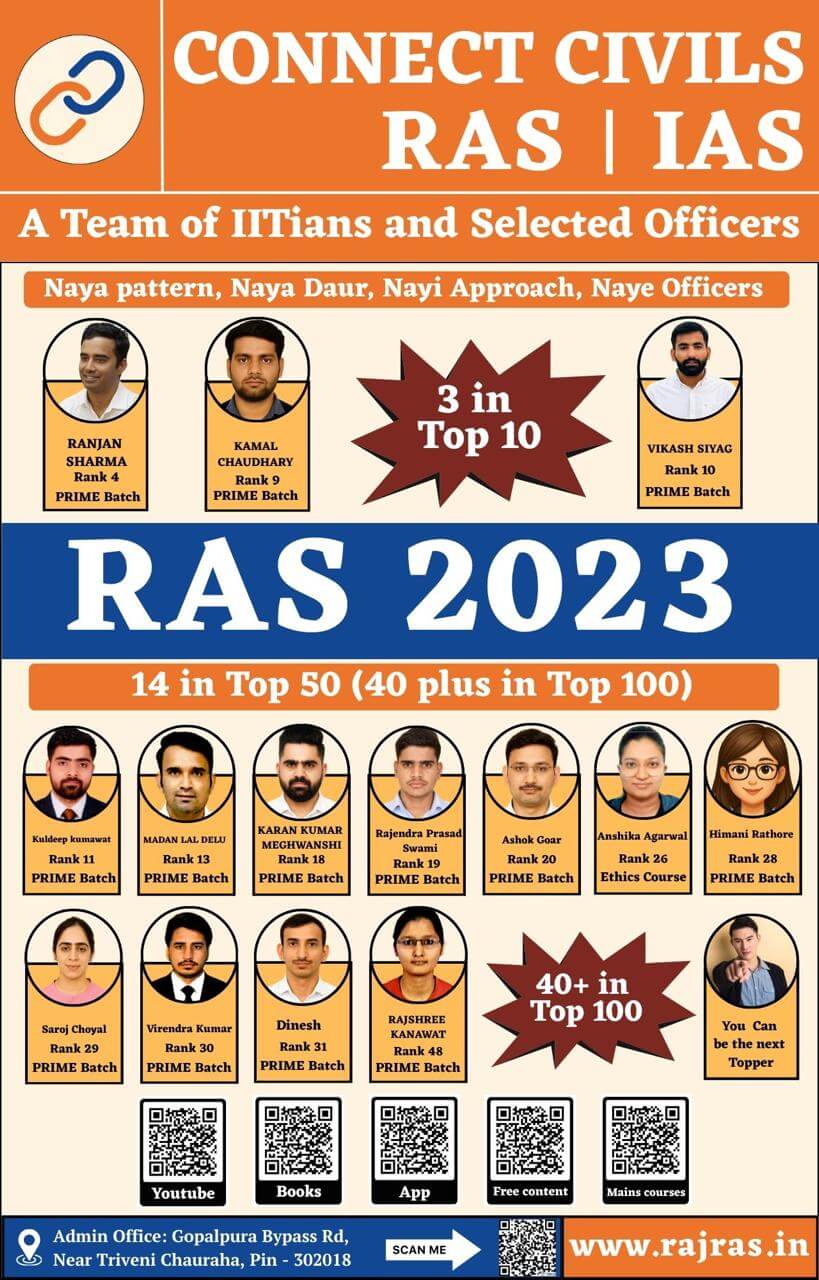The Salient Events of the 19th and 20th Centuries represent a crucial phase in Rajasthan History, marked by significant social, political, and economic changes. This period saw the increasing influence of the Marathas and the British, the emergence of social reforms, and the rise of public consciousness across the region.
In this chapter, we will study the following important topics:
Previous year Questions related to Salient events of 19th & 20th centuries
| Year | Question | Marks |
| 2023 | Critically evaluate the attitude of the Jaipur Praja Mandal towards.Quit India Movement. | 5 M |
| 2021 | Critically examine the Begun Peasant Movement of Rajasthan. | 5 M |
| 2021 | Write a short note on the integration of Sirohi in “United Rajasthan’’. | 5 M |
| 2018 | Who were Doongji and Jawaharji ? | 2 M |
| 2018 | Discuss the causes of peasant unrest in the Jagirdari areas of Rajasthan. | 5 M |
| 2016 | What was Mewar Pukar ? | 2 M |
| 2016 | Elaborate the causes of Political Awakening in Rajasthan during the early 20th century. | 10 M |
| 2016 | Underline the basic features of the Prajamandal Movement in Rajasthan. | 10 M |
| 2013 | What was the attitude of Jaipur Prajamandal towards the Quit India Movement of 1942 ? | 2 M |
FAQ (Previous year questions)
The early 20th century saw a political awakening in Rajasthan, fueled by socio-economic grievances, the spread of reform movements, and the growing influence of nationalism. The region, historically marked by feudal oppression and colonial exploitation, began to witness mass mobilization for political change, setting the foundation for the independence movement.
Causes of Political Awakening –
Agrarian Unrest: The Peasants Revolt: The oppressive feudal system, with heavy taxes, levies (laag-Baag), and forced labor (begar), led to peasant revolts like the Bijolia Peasant Movement (1905). Leaders such as V.S. Pathik and Manikya Lal Verma challenged the injustices of local jagirdars.
Social Reform Movements – Arya Samaj: Swami Dayanand Saraswati’s visit to Rajasthan in the late 19th century and the spread of Arya Samaj ideology sparked social reforms focused on Swadharma, Swaraj, Swadesh, and Swabhash. Arya Samaj branches, such as the Vedic Yantralaya Press in Ajmer and Paropkarini Sabha in Udaipur (1883), emphasized nationalism and social justice, significantly raising political awareness.
Rise of the Educated Middle Class: The spread of English education gave rise to a middle class of lawyers, teachers, and journalists, who, despite being qualified, were denied higher positions in administration. This spurred demands for political reforms and aligned Rajasthan with the broader nationalist struggle. Leaders like Jai Narain Vyas and Master Bhola Nath played key roles.
Role of Newspapers: Publications like Rajasthan Kesri (1920) and Naveen Rajasthan (1922) became crucial in spreading nationalist ideas. These newspapers provided a platform for political discourse and amplified the demand for independence.
Role of Transportation : The development of transportation, including railways and roads, improved connectivity, aiding the spread of nationalist ideas and political mobilization across Rajasthan.
Social Institutions and Reform: Institutions such as Sewa Samitis and Hitkarni Sabhas promoted reforms and political awareness, particularly in regions affected by feudal exploitation, fostering unity and participation.
Failure of Militant Movements: Early militant movements, inspired by revolutionaries like Ras Behari Bose, lacked sustainability. This shift towards Gandhian non-violence gained broader support for the independence cause.
Other reasons : The Swadeshi movement inspired Rajasthanis to embrace self-reliance and contributed to the growing demand for independence. The economic hardships caused by the First World War (1914–1918) further fueled discontent against British policies. Additionally, the business community, exposed to progressive ideas in metropolitan centers, actively pushed for an independent India.
The political awakening in Rajasthan in the early 20th century was driven by a combination of these above mentioned factors, alongside the rise of political leaders and social institutions, which collectively laid the foundation for the region’s significant contribution to India’s freedom struggle.
Salient events of 19th & 20th centuries / Salient events of 19th & 20th centuries

